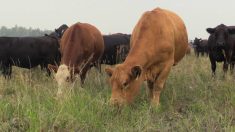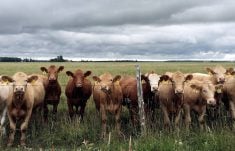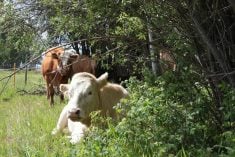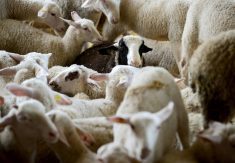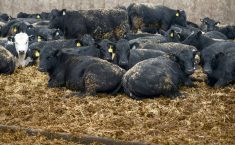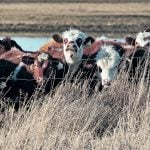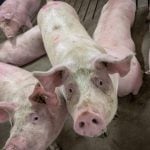There aren’t any cases of foot and mouth disease in Canada, but other nations have had recent infections, and Canadian experts are focusing on preventative measures to safeguard the nation’s herds.
In a recent webinar hosted by the Beef Cattle Research Council Feb. 12, industry leaders outlined their plans for biosecurity, surveillance and emergency response against any possible incursion of the disease.
Why it matters: An outbreak of foot and mouth disease (FMD) in Canada could cost up to $65 billion and lock down trade, according to Canadian industry.
Read Also

Real farm talk on switching to open sow housing
What actually worked for these Prairie pig farmers when it came time to swap gestation stalls in their barns for group sow housing? What were the results?
In a fact sheet put out by the Government of Canada, FMD is a “severe, highly contagious viral disease of cattle, swine and sheep, and other cloven-hoofed animals such as goats, deer, and bison. Horses are not affected.”
There are seven known variations of the virus: A, O, C, SAT1, SAT2, SAT3, and Asia1. The incubation period ranges from two to 14 days and symptoms include fever, blisters on the tongue, lips, mouth, teats and hoofs, excessive salivation, depression, anorexia, lameness and reluctance to move.
It’s also a disease that has mimics. Its symptoms can look similar to vesicular stomatitis, swine vesicular disease, vesicular exanthema of swine, bluetongue, rinderpest, Seneca Valley virus, mucosal diseases like BVD, infectious bovine rhinotracheitis, bovine papular stomatitis and even contact dermatitis.
The progression of lesions follows a predictable pattern. On the first day, fluid-filled vesicles form with a blanched overlying skin. By the second day, the vesicles rupture, exposing a pit of raw, red skin surrounded by a sharp edge of outer skin. By the third and fourth days, infected skin has sloughed off , yellow-ish fibrin deposits appear, and new skin has begun to grow in at the borders. On days five to seven, there’s signficiant skin regrowth, those fibrin deposits start to retreat and things have started to scar. Day 7 and on, new outer skin has regrown and scars continue to form.

FMD is most commonly spread by the movement of infected animals, contaminated animal products, vehicles, and even by wind.
The projected economic impact of an FMD outbreak in Canada ranges from $19.4 billion for a small outbreak to $65.2 billion for a larger one, said Dr. Genevieve Toupin, veterinarian and the national veterinary program manager with the Canadian Food Inspection Agency (CFIA).
Toupin characterized a small outbreak as something like 50 infected sites, “but if we end up with a…large outbreak in areas where the density of susceptible animals is greater and let’s say we reach 1,500 infected premises, then we reach close to $65 billion dollars.”
That’s “huge” for affected industries, she noted.
Keeping FMD out
Canada has been free of FMD since 1952, when an outbreak hit Saskatchewan and caused serious hardship for the beef sector.
Strict import controls help mitigate risks of the disease making a return to the country, officials say, but illegal meat products and other biosecurity breaches remain a concern.
The risks associated with international travel and contaminated imports are significant, said Dr. Murray Gillies, a veterinarian and co-ordinator of Canadian Animal Health System, a division of Animal Health Canada.
The World Organization of Animal Health has a three-level framework for noting a country’s FMD status. A country can be FMD-free, where the no cases have been found in so long that vaccination is not practiced (the gold standard, which Canada enjoys); FMD-free, where vaccination is practiced; and FMD infected.
Emergency preparedness remains a top priority, with Canadian officials closely monitoring global trends and strengthening vaccination strategies, if there were an FMD case to emerge.
The role of vaccines
A promised FMD vaccine bank was one of the line items in Canada’s 2023 federal budget, responding to industry concerns that, shoud there be an FMD problem in North America, Canada would be too reliant on American sources for that emergency vaccine. Last summer, the federal gvoernment started shopping for vaccine manufacturers to fill the bank with concentrated vaccines.
Emergency vaccination would play an important role in controlling potential outbreaks, Toupin said.
“The purpose of the FMD vaccine is to limit the spread…remember, this is not COVID. The objective is not to prevent animals from getting sick. It is mainly to reduce the spread of the virus and shedding by these animals.”
Canada has developed contingency plans to deploy vaccines rapidly should an outbreak occur, but vaccination is not a standalone solution, the experts also said. It is also not a preventative tool, as is the case in other diseases. FMD vaccines would only be deployed during an outbreak, and primarily in the infected zone where there is a high density of susceptible animals.
There is no single FMD vaccine as the virus has too many different strains. During an outbreak, the CFIA would identify the strain, matching it with a strain in the vaccine bank and then ship vaccines where they are needed.
“Vaccination does not change a need to depopulate all infected animals,” Toupin said. “Vaccination should be done as an add-on to the stamping out of the infected premise. Actually, we will decide to use vaccination when we know we’re not going to be able to depopulate quickly enough these animals,” such as in large feedlots.
Plans laid
If FMD were to make a Canadian comeback, the CFIA’s goal would be to recover the nation’s status as an FMD-free country, where vaccination is not practiced, as quickly as possible, Toupin said.
The CFIA’s FMD response plans are written with this objective in mind.
Early detection and reporting would also be integral to stopping any outbreak of FMD in Canada. Complacency in identifying symptoms can wreak havoc, so it’s important that veterinarians and producers take immediate action if they suspect an infection, Toupin added.
“As vets, there’s not much we’re going to be able to do until it’s been reported to us, and the longer it takes for that to get reported to us, the more risk we are for the spread of this disease.”
Movement controls are another critical component of an outbreak response. In the event of an outbreak, control zones and livestock shipment restrictions would slam down in impacted areas. Movements would be monitored on a premise-by-premise basis; quarantining each one would be cumbersome.
“During that time, the circulation of service providers within the zone are not legally prohibited, but are discouraged,” Toupin said.
Biosecurity practices, as with other diseases, also remain a fundamental defense against FMD. Farms must implement strong hygiene and tracking measures to reduce risks, Gillies said. Best practices include personal hygiene for staff; wearing clean protective outerwear and footwear; routine sanitation of equipment, vehicles and instruments; proper storage and disposal of consumables; safe handling of laboratory specimens and self-quarantine if highly contagious diseases are suspected.
Proactive measures are non-negotiable when it comes to preventing a FMD outbreak, Gillies said. Veterinary professionals should review their clients’ biosecurity plans and discuss different scenarios with producers, including incident command training, emergency preparedness on the farm, keeping a list of contacts up to date, reaching out for support resources and staying informed of any animal disease news.




